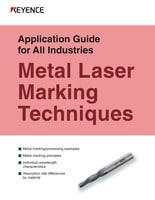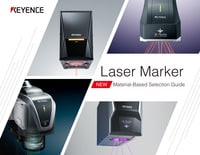Laser Marking Systems / Laser Markers
How Does Laser Engraving Aluminum Work?
-
Tags:
- Metal , Laser Engraving , Laser Marking
Aluminum is the most common metal on the Earth’s crust, and its properties make it a great fit for many manufacturing applications.
Aerospace, automotive, building, and construction industries flock to aluminum for its lightweight, anti-corrosive, durable, and flexible properties. Regardless of the difference in application, many uses of aluminum require some mark, whether that be for traceability, part assembly, or identification.
Since aluminum is such an easy metal to work with, any marking method like ink, labeling, and printing can be used for adding these marks. However, that doesn’t mean they are the best choice. Enter in: laser engraving aluminum.
In this blog, we discuss laser engraving aluminum and why it goes hand in hand with the properties of the highly sought-after aluminum.
Understanding Laser Engraving on Aluminum
Aluminum’s best-selling qualities are emphasized with laser engraving aluminum. Laser engraving withstands harsh environments that aluminum is used for, survives extra manufacturing processes, and doesn’t add extra consumables to ensure aluminum’s sustainability.
Laser markers are able to engrave into the surface of the aluminum or create contrasting marks, all in a fully permanent sense. These marks could add traceability, create logos or images, or simply mark a manufacturing date.
We’re here to provide you with more details.
Reach out today!

Types of Aluminum Suitable for Laser Engraving
Laser engraving aluminum is a broad category, and within aluminum engraving, there are different types of aluminum and types of lasers.
Bare Aluminum
Bare aluminum is the most basic type of aluminum, and it’s exactly what it sounds like; it’s the bare sheet of aluminum with no additional coating. This type of aluminum generally purposes a fiber or hybrid laser as their wavelengths are optimized for absorption by metals.
These lasers are able to create a great deal of contrast and mark extremely fast due to their high output power.
Bare aluminum engraving applications include but aren’t limited to electrical components, construction materials, heat sinks, and substrates. For these applications, laser marking aluminum adds traceability and assembly marks. Laser engravers excel at laser marking aluminum of different shapes and sizes, and non-geometric products are typical for these applications.
Many manufacturers are curious about the possibility of using other popular laser machines like CO2 or diode lasers for bare aluminum. This is a common question, and it is possible. However, these other lasers are not the best for bare aluminum engraving.
To mark with a CO2 laser, the bare aluminum requires a temporary pre-treatment paste to prevent the bare aluminum from reflecting the beam. The paste ensures that sublimation occurs, and after the CO2 laser finishes, the paste is washed off with water.
Anodized Aluminum
Anodized aluminum is bare aluminum with an additional permanent oxide layer coating. The oxide coating increases resistance against corrosion and UV damage.
Like bare aluminum, laser engraving on anodized aluminum also utilizes sublimation. However, because of the additional layer, there are more options for laser engraving. CO2 lasers, fiber lasers, and hybrid lasers are all commonly purposed on anodized aluminum.
Anodized aluminum engraving is popular in the aerospace and aircraft industry for interiors and components. These industries have strict traceability requirements, so laser engraving is ideal because of its permanency.
Using laser engraving for anodized aluminum is especially beneficial because this type of aluminum often has dyes, paints, lubricants, and adhesives attached. The laser-engraved mark withstands all of these additional layers. These lasers can either fully remove the anodized layer in order to show the bare metal below (CO2) or partially remove the anodization in order to create a high level of contrast.
Powder-Coated Aluminum
Powder-coating aluminum is another type of bare aluminum with an additional coating. But instead of an oxide layer, the coating is a powder coating applied with a spray gun. Similar to anodization, this provides an additional layer of protection against rust, corrosion, and scratches and also provides a level of aesthetics.
Like anodized aluminum, powder-coated aluminum is engraved with sublimation and is generally conducted using a fiber or hybrid laser, with some uses for a CO2 laser as well.
Powder-coated aluminum makes up metal railings, home decor, and outdoor furniture.
Using laser engraving for these applications is perfect for the sleekness of these applications.
Discover more about this product.
Click here to book your demo.

Customization and Personalization with Aluminum Engraving
Aluminum and laser engraving are highly customizable processes. Anodized and powder-coated aluminum can be colored beyond just black, white, or gray—even blue, pink, green, or red.
Laser engraving is customizable because a laser engraver can do many tasks of different shapes, sizes, and designs.
Curious about our pricing?
Click here to find out more.

Do You Need to Laser Engrave Aluminum?
Laser engraving aluminum is the best way to keep up with industry standards and get the most benefits from your aluminum. Aluminum is known for its durability, lightweightness, and anti-corrosion, so why not use a marking method that is permanent, precise, and adds no additional consumables?
KEYENCE offers Fiber, Hybrid, UV and CO2 laser marking systems that you can choose from depending on your type of aluminum and other manufacturing needs. If you want to learn more about turning your aluminum engraving into a laser-automated process, contact us today!
We’re here to provide you with more details.
Reach out today!

Related Downloads

This quick guide introduces the basics of metal marking. Learn why different wavelengths matter and discover the various ways laser light interacts with metal parts.


![LASER TECHNICAL GUIDE [An Introduction]](/img/asset/AS_69962_L.jpg)

